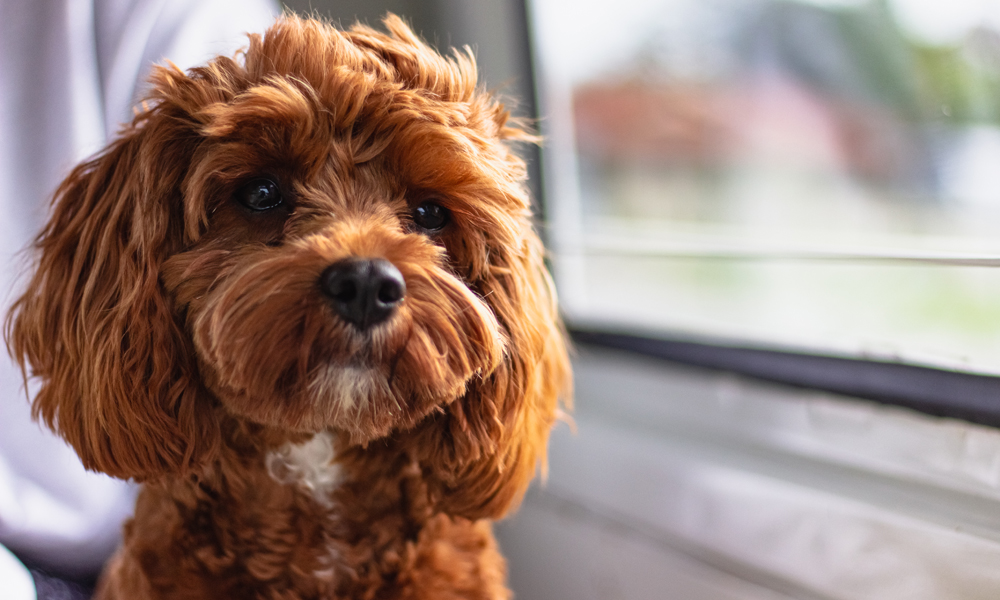The Cavoodle, also known as a Cavapoo or Cavadoodle, is a cross between two beloved and popular dog breeds, the Poodle and the Cavalier King Charles Spaniel. Intelligent, gentle and affectionate, this little ball of fluff is a perfect family dog that gets along well with children and other pets. Despite their small stature, they make great guard dogs, too. Thinking about adding a Cavoodle to your brood? Here are some facts to help you decide if the breed is right for you.
Cavoodles at a glance
Origin: USA or Australia (hotly contested!)
Size: Small. Size varies depending on the type of poodle, toy or miniature, that is the Cavoodle’s parent.
Life expectancy: 10-15 years
Breed type: Toy/designer dog hybrid
Appearance: A Cavoodle’s coat can be silky like a Cavalier King Charles Spaniel’s, or curly like a poodle’s. Colors include red, brown, black, chestnut and tricolor.
Energy level: Medium to high
Fun fact: Cavoodles are hypoallergenic! This is a great pup for you if you’re allergic to dogs.
Top job: Playing and cuddling! They love to be around people, play with balls or toys, or simply curl up on your lap while you watch a movie.
Bottom line: A Cavoodle is a loving family dog that forms great attachments to its humans.
Cavoodle traits
They’re perfect family dogs
This intelligent, gentle, even-tempered breed gets along well with people of all ages, from your new baby to your great aunt. They like other animals, too. Your Cavoodle will be a happy and loving addition to your household.
Cavoodles do well in public places
Dog park? Visit often. Pet-friendly restaurant? Your Cavoodle will be a perfect gentleman or lady while you dine. Your pet will be happy and well mannered whenever and wherever he is with you.
They’re good watchdogs
Your Cavoodle has inherited a hunting dog’s keen awareness of its surroundings, and will likely bark when strangers arrive at your home. However, this smart cookie will quickly learn whether that stranger is a threat to you and your family. If it’s a friend coming for dinner, your Cavoodle will warm up as soon as he sees you welcoming the person into your home.
They love attention
Cavoodles crave attention from their families, loving nothing more than being in a household with lots of people. However, this can lead to separation anxiety, so it’s important to train your pup to be OK alone. Also, this is not a breed that will do well living alone in a doghouse in your backyard.
They need more exercise than most small dogs
Daily exercise is a must for Cavoodles. A small yard or outdoor space is fine for potty breaks, so this breed is ideal for urban living, but you should plan on taking your Cavoodle on a nice walk once or twice each day. Even getting out of the house with you while you run errands is fun and exciting, but don’t be tempted to pop your pup into your purse or otherwise carry him with you. Cavoodles love getting around on their own steam and will be happy keeping up with you whether you’re walking out in nature or down Fifth Avenue.
Cavoodle history
The origins of the Cavoodle are hotly contested. They are one of the most popular pups in Australia, and the Aussies claim that Cavoodles were first intentionally bred there in the 1990s as a cross between a Cavalier King Charles Spaniel and a poodle. Not so fast, say American breeders, who contend that the Cavoodle was first bred in the United States in the 1950s. That was a time when breeders were interested in developing hypoallergenic dogs. The poodle is one of the most well-known hypoallergenic breeds because they have hair, not fur, (what is the difference? )very low levels of dander, and they do not shed. So breeders were experimenting with crossing poodles with other breeds to create more hypoallergenic types of dogs.
Regardless of which origin story is true, Cavoodles are the much-beloved result.
Cavoodle mystery!
Since the Cavoodle is a mixed breed, pet owners can get a mixed bag of traits. Just as some human children take after their mother and some take after their father, Cavoodles can favor either their spaniel or poodle parents. Or, they can be a blend of both. That goes for appearance as well as personality traits. That’s why it can be a happy surprise to see a new litter of pups, each of them a bit different from the others.
Cavoodle coats and grooming
Grooming your Cavoodle will depend on the type of coat your pup has. It can be silky, like that of a spaniel, or curly, like that of a poodle. If your pup sports a more spaniel-like coat, you’ll need to brush frequently and give regular baths. Tangles are the main thing you’re looking to prevent. But if your Cavoodle has a curly, poodle-like coat, you need to be on the lookout for mats, which are deep snarls that form on the legs and near the skin if you don’t brush regularly. Once those mats form, its best just to cut them out to avoid the ordeal of trying to brush them out. Better, though, to prevent them by brushing your Cavoodle every day. They love it.
Cavoodles have hair, not fur. In general, the difference between hair and fur is coat density, growth, and shedding. Dogs with fur, like Huskies for example, have a dense undercoat that sheds like crazy a few times each year. You don’t need to get them clipped because their fur does not grow long like hair does, but a good grooming can remove the underfur that is shedding. Dogs with hair, like Cavoodles, have a finer coat that does not shed, and needs to be clipped every couple of months because it grows. A trip to the groomer is also a great time to get their nails clipped as well.
One other grooming note to be aware of: undereye stains. They’re common with both spaniels and poodles, and are usually the result of excessive tear production. A nice, gentle wipe with a warm washcloth every day will take care of that.
Best environments for Cavoodles
Cavoodles are famously adaptive and easy, taking to just about any living situation and making it their own. Whether you have a house with a yard, a small apartment in the city, or anything in between, your Cavoodle will call it home and adapt just fine. They are lap dogs and love nothing better than cuddling up with you on the couch. That’s the spaniel in them. The poodle side is more energetic, loving walks and outings.
Health concerns
Many breeders disagree on whether purebred or hybrid dogs have more health concerns, but according to the Institute of Canine Biology, mixed breed dogs fare better than their purebred brothers. You’ll want to keep on the lookout for hip dysplasia, epilepsy and eye diseases, in addition to ear infections. Also, as your pup ages, you may want to invest in a ramp or stairs so he can climb onto the couch or your bed with ease.
Watch your pet’s diet, as well. Make sure you’re giving your best friend the best food to ensure his long and healthy life. Find NutriSource at your local, independent pet retailer. Your pet’s diet likely also includes treats. For more information about doling out those treats, read our blog, How Many Treats Should I Feed My Dog?


